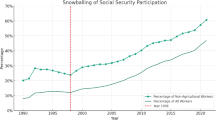Summary and conclusions
I have argued that the spatial convergence of per capita incomes and income distributions lead to the spatial convergence of fiscal regimes and that convergence diminishes opportunities for Tiebout-type moves in the economy. Considerable empirical evidence confirms the hypothesis. States with relatively low initial levels of taxation have had relatively higher growth rates of taxation. Low per capita income states have had higher growth rates of real per capita incomes than have had high per capita income states. The high economic growth rate states have had lower growth rates of taxation than the low income growth rate states. Spatial convergence of per capita incomes is associated with spatial convergence of fiscal regimes. Furthermore, there has been a spatial convergence in income distributions. Increased equality of income empirically is associated with increased size of the fiscal regime, confirming the public choice insight.
The spatial convergence of fiscal regimes has diminished the gains from Tiebout-type moves. As such, fiscal convergence diminishes the opportunity for citizen-voters to reveal their preference for collective goods through migration. Of course, at the limit, where per capita incomes and the income distribution are invariant spatially, the spatial convergence of fiscal regimes makes the Musgrave-Samuelson problem of revealed preference for collective goods as intractable at the state and local levels as at the national level. Tiebout-type moves no longer allow escape from Leviathan.
Similar content being viewed by others
References
Barro, R.J. (1990). Government spending in a simple model of endogenous growth. Journal of Political Economy. (In press).
Borcherding, T.E., Bush, W.C. and Spann, R.M. (1977). The effects on public spending of the divisibility of public outputs in consumption, bureaucratic power, and the size of the tax-sharing group. In T.E. Borcherding (Ed.), Budgets and bureaucrats, 211–228. Durham: Duke University Press.
Brennan, G. and Buchanan, J.M. (1980). The power to tax: Analytical foundations of a fiscal constitution. Cambridge: Cambridge University Press.
Buchanan, J.M. and Tullock, G. (1962). The calculus of consent. Ann Arbor: The University of Michigan Press.
Cass, D. (1965). Optimum growth in an aggregative model of capital accumulation. Review of Economic Studies 32: 233–240.
DiLorenzo, T.J. (1983). Economic competition and political competition: An empirical note. Public Choice 40: 203–210.
Forbes, K.F. and Zampelli, E.M. (1989). Is Leviathan a mythical beast? American Economic Review 79 (June): 568–577.
Giertz, J.F. (1981). Centralization and government budget size. Publius 11 (Winter): 119–128.
Grossman, P.J. (1989). Fiscal decentralization and government size: An extension. Public Choice 62 (July): 63–69.
Henderson, J.W. and Scully, G.W. (1989). Earnings inequality across skill levels: An application of entropy of the human capital model. In D.J. Slottje (Ed.), Research on economic inequality, Vol. 1, 235–247. Greenwich: JAI Press, Inc.
Koopmans, T.C. (1965). On the concept of optimal economic growth. In The econometric approach to development planning. Amsterdam: North Holland.
Nelson, M. (1986). An empirical analysis of state and local tax structure in the context of the Leviathan model of government. Public Choice 49: 283–294.
Nelson, M. (1987). Searching for Leviathan: Comment and extension. American Economic Review 77 (March): 198–204.
Niskanen, W.A., Jr. (1971). Bureaucracy and representative government. Chicago: Aldens and Atherton.
Oates, W.E. (1985). Searching for Leviathan. American Economic Review 75 (September): 748–757.
Peltzman, S. (1980). The growth of government. Journal of Law and Economics 23 (October): 209–287.
Scully, G.W. (1969). Interstate wage differentials: A cross section analysis. American Economic Review 59 (December): 757–773.
Scully, G.W. (1990). Rent-seeking in U.S. government budgets, 1900–88. Public Choice (forth-coming).
Slottje, D.J. (1989). The structure of earnings and the measurement of income inequality in the U.S. Amsterdam: North-Holland.
Solow, R.M. (1956). A contribution to the theory of economic growth. Quarterly Journal of Economics 70 (February): 65–94.
Summers, R. and Heston, A. (1984). Improved international comparisons of real product and its composition: 1950–1980. Review of Income and Wealth (June): 207–262.
Tiebout, C.M. (1956). A pure theory of local expenditures. Journal of Political Economy 64 (October): 416–424.
Tullock, G. (1965). The politics of bureaucracy. Washington: Public Affairs Press.
Tullock, G. (1983). Economics of income distribution. Boston: Kluwer-Nijhoff.
Tullock, G. (1986). The economics of wealth and poverty. New York: New York University Press.
Wallis, J.J. and Oates, W.E. (1988). Does economic sclerosis set in with age? An empirical study of the Olson hypothesis. Kyklos 41(3): 397–417.
Zax, J.S. (1989). Is there a Leviathan in your neighborhood? American Economic Review 79 (June): 560–567.
Author information
Authors and Affiliations
Rights and permissions
About this article
Cite this article
Scully, G.W. The convergence of fiscal regimes and the decline of the Tiebout effect. Public Choice 72, 51–59 (1991). https://doi.org/10.1007/BF00135546
Accepted:
Issue Date:
DOI: https://doi.org/10.1007/BF00135546




